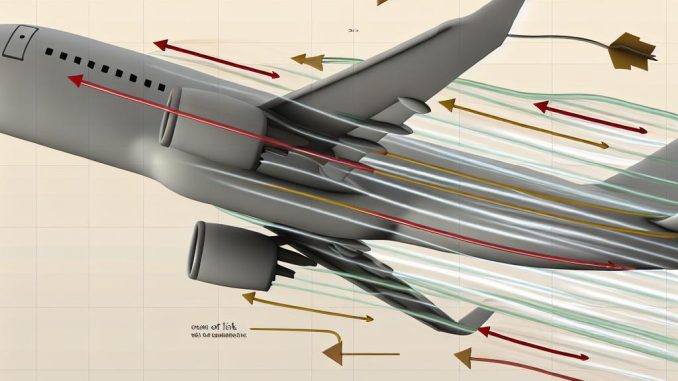
The Fundamentals of Flight
The science of flight is an intriguing aspect of physics that encompasses numerous principles essential to understanding how an aircraft can traverse the skies. At its core, the ability of a plane to stay airborne represents a sophisticated interplay of four principal forces: lift, weight, thrust, and drag. Each of these forces bears a distinct responsibility in upholding an aircraft’s stable flight. By delving deeper into each force and how it contributes to flight, we can gain an appreciation for the complex dynamics of aviation.
Lift: The Principal Force
Lift serves as the aerodynamic force that counteracts an aircraft’s weight, facilitating its takeoff, sustained flight, and eventual landing on a runway. This force is primarily generated due to the aircraft’s wings and their thoughtfully engineered design. The shape of the wing, commonly referred to as an airfoil, is pivotal as it often features a curved upper surface juxtaposed with a flatter lower surface.
Generating Lift: Bernoulli’s Principle
This wing design prompts air flowing over the top of the wing to travel at higher speeds compared to the air moving beneath it. Consequently, there is a reduction in pressure atop the wing, facilitating lift generation. This aerodynamic phenomenon finds its explanation in Bernoulli’s Principle, which posits that an increase in the speed of a fluid occurs concurrently with a decrease in its pressure or potential energy.
Role of Angle of Attack
The angle of attack, defined as the angle between the wing’s chord line and the incoming air, also plays a pivotal part in lift generation. By increasing the angle of attack, pilots can enhance lift to an optimum point. However, surpassing this optimal angle can result in stalling, where lift experiences a substantial decline, highlighting the necessity for precise control.
Weight: The Gravitational Pull
Weight is the force exerted by gravity, consistently pulling the aircraft towards the Earth’s surface. It operates directly in opposition to lift. The design of an aircraft, including material selection and structural integrity, is instrumental in minimizing weight while preserving strength and stability. Engineers meticulously balance these elements to ensure that the aircraft can produce sufficient lift to counteract its weight, ensuring effective and safe flight operations.
Considerations in Aircraft Design
Understanding weight distribution and managing payload are crucial in aircraft design. Contemporary aircraft utilize lightweight materials, such as composites, that offer strength without unnecessary heft, compelling engineers to innovate continuously for optimal designs.
Thrust: Propelling the Aircraft Forward
Thrust stands as the force generated by the aircraft’s engines to propel it in a forward direction. This propulsion is critical as it facilitates the necessary airflow over the wings, which aids in lift production. Depending on the aircraft type, jet engines, propellers, or turbofans may be employed to supply thrust, with each operating on the fundamental principle of Newton’s Third Law of Motion.
Newton’s Third Law in Action
According to Newton’s Third Law, every action corresponds with an equal and opposite reaction. Therefore, the expulsion of gases or air at high velocities generates thrust, effectively propelling the aircraft in the opposite direction. This principle underscores the mechanical ingenuity behind engine design and efficiency.
Drag: Resisting Motion
Drag emerges as the aerodynamic force that counters an aircraft’s motion through air, acting in opposition to thrust. It arises from the friction between air molecules and the aircraft’s surface, coupled with the pressure differential at the aircraft’s forefront and rear, known as form drag.
Types of Drag
Drag can be classified into several types, each with distinct characteristics. Parasitic drag, a combination of form, friction, and interference drag, and induced drag, which relates to lift production, are major categories. Effective aircraft design hinges on minimizing these drags through various strategies, such as streamlining the aircraft’s shape and carefully managing the wing’s geometry and surface texture.
The Wing’s Role: Lift and Control
Beyond their pivotal role in lift generation, wings are critical in steering and controlling the aircraft. Components such as flaps, ailerons, and slats are adjustable sections of the wing, refining lift and drag parameters to bolster stable flight and navigability.
Flaps and Ailerons
Flaps come into use predominantly during takeoff and landing, conditions necessitating increased lift at lower speeds. Conversely, ailerons assist in the aircraft’s rolling maneuver, enabling seamless turns and adjustments for level flight. Mastery over these elements is essential for pilots to execute precise and controlled maneuvers.
The Interplay of Forces in Flight
In the dynamic environment of flight, maintaining a balance between these forces is imperative for an aircraft to stay airborne. Pilots, aided by sophisticated aircraft systems, perpetually adjust various flight parameters to sustain this equilibrium. This adjustment might involve amplifying thrust during takeoff or modulating wing flaps during landing procedures. The comprehensive understanding of these four forces is not only vital for aircraft design and operation but also enriches our knowledge in the expansive domains of physics and engineering.
Recognizing how these forces harmonize to facilitate flight is crucial for those involved in aviation and related fields. By appreciating the meticulous calculations and design philosophies that underpin modern aircraft, we enhance our insight into how humans conquered air travel. This assiduous application of physics principles enables aircraft to fly passengers and cargo across continents safely and efficiently, revolutionizing global transportation and connectivity.
